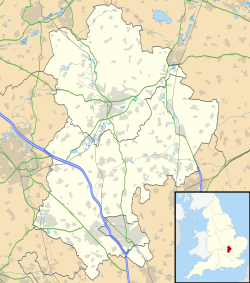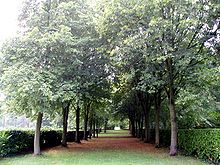| Whipsnade Tree Cathedral | |
|---|---|
 The South Transept of Whipsnade Tree Cathedral The South Transept of Whipsnade Tree Cathedral | |
  | |
| Type | Garden |
| Location | Whipsnade, Bedfordshire, England |
| Coordinates | 51°51′11″N 0°32′15″W / 51.85296°N 0.53740°W / 51.85296; -0.53740 |
| Area | 9.5-acre (3.8 ha) |
| Established | 1930s |
| Founder | Edmond Blyth |
| National Register of Historic Parks and Gardens | |
| Type | Grade I |
| Designated | 10 February 2017 (2017-02-10) |
| Reference no. | 1439326 |
Whipsnade Tree Cathedral is a 9.5-acre (3.8 ha) garden in the village of Whipsnade in Bedfordshire, England. It is planted in the approximate form of a cathedral, with grass avenues for nave, chancel, transepts, chapels and cloisters and "walls" of different species of trees.
The tree cathedral was planned by Edmond Blyth in the 1930s as an act of "Faith, hope and reconciliation" in response to his memories of World War I. As a cadet at Sandhurst in 1916 Blyth had made close friends called Arthur Bailey, John Bennett and Francis Holland who were all killed prior to the end of the war. In 1930 he paid a visit to Liverpool Cathedral, which was then under construction. Blyth wrote: "As we drove south through the Cotswold hills on our way home... I saw the evening sun light up a coppice of trees on the side of a hill. It occurred to me then that here was something more beautiful still and the idea formed of building a cathedral with trees." Work began in 1932 and continued in stages. The site became overgrown during World War II, but development recommenced after the end of the war. The first religious service at the site was held in 1953, and services continue to this day.

In 1960 the Tree Cathedral was accepted as a gift by the National Trust. The independent Whipsnade Tree Cathedral Fund is responsible for the religious use of the site. Services have been conducted by many different denominations. It is Grade II listed on the Register of Historic Parks and Gardens.
The Tree Cathedral contains chapels meant for each of the four seasons.
Trees

The cathedral incorporates the following trees.
- Ash (cloister walk)
- Beech (summer chapel, corner towers)
- Cherry
- Cedar
- Cypress (dew pond enclosure)
- Hornbeam (south entrance avenue)
- Horse Chestnut (transepts, western approach)
- Lime (nave)
- Lombardy Poplar (corner towers)
- Norway Maple (Wallsam Way)
- Norway Spruce (Christmas chapel)
- Oak (south entrance, nave, Gospel Oak)
- Rowan (summer chapel)
- Silver Birch (chancel, corner towers)
- Scots Pine (corner towers, north transept, western approach)
- Whitebeam (south entrance, summer chapel)
- Willow (dew pond enclosure)
- Yew (summer chapel, Wallsam Way, chancel)
The site also includes a number of notable shrubs including Berberis, Cotoneaster, Dogwood, Flowering Currant, Holly, Hazel, Lilac, Laurustinus, Laurel, May, New Zealand Holly, Philadelphus, Privet, Rhododendron, and Wild Rose.
Nearby

The village of Whipsnade contains houses named after Mr Blyth (Blythswood) and his friends Arthur Bailey and John Bennett (Bailey Cottage and Bennetts Cottage).
The Icknield Way Path passes adjacent to the Tree Cathedral on its 110-mile (180 km) journey from Ivinghoe Beacon in Buckinghamshire to Knettishall Heath in Suffolk. The Icknield Way Trail, a multi-user route for walkers, horse riders and off-road cyclists also passes adjacent.
References
- Historic England, "Whipsnade Tree Cathedral (1439326)", National Heritage List for England, retrieved 18 March 2018
- Halstead, Robin; Hezaley, Jason; Morris, Alex; Morris, Joel (2007). Far from the Sodding Crowd. Penguin books. p. 150. ISBN 978-0-7181-4966-6.
- Information board, car park of Whipsnade Tree Cathedral
- Olga Norford (4 March 2024), "Volunteer Pam awarded MBE for exceptional services to the community in Whipsnade", Luton Today
- "Home". IcknieldWayTrail.org.uk.
External links
- Whipsnade Tree Cathedral information at the National Trust
- Windy Sayles website, with information about the Tree Cathedral
- grid reference TL007181